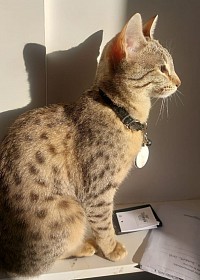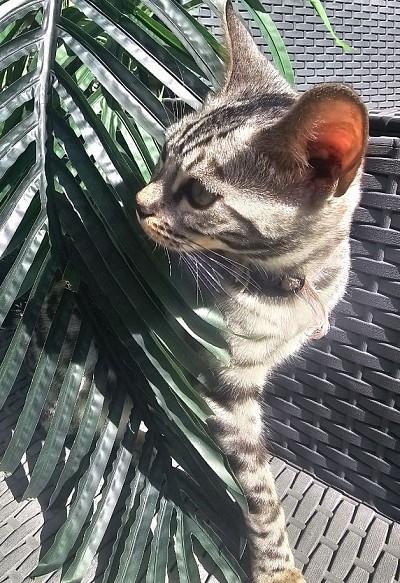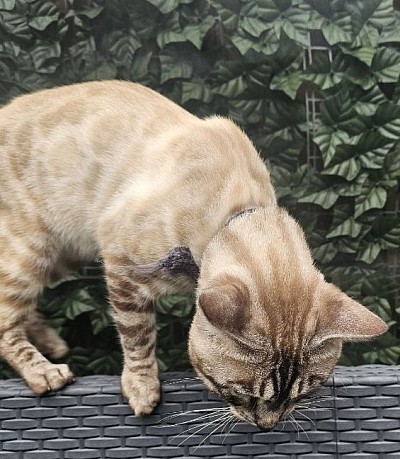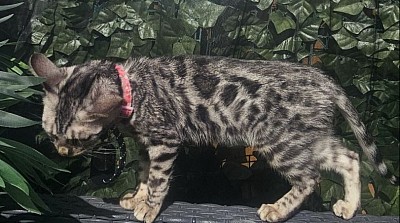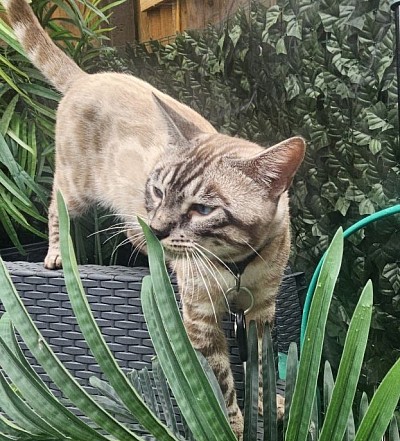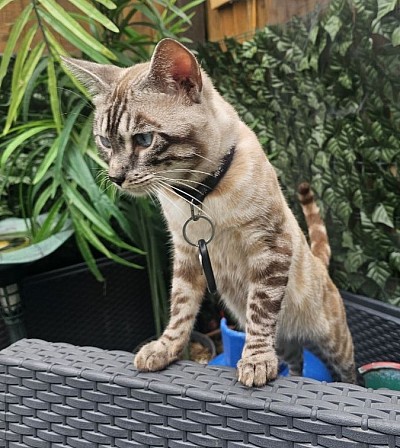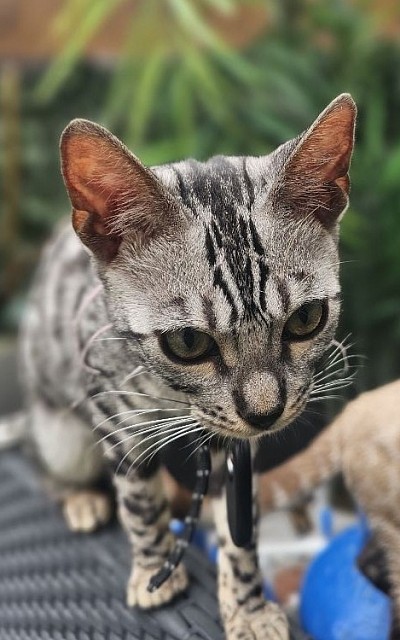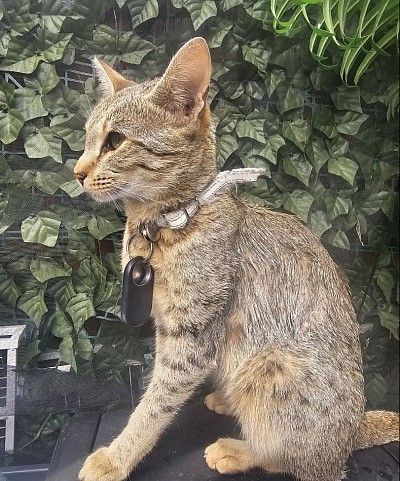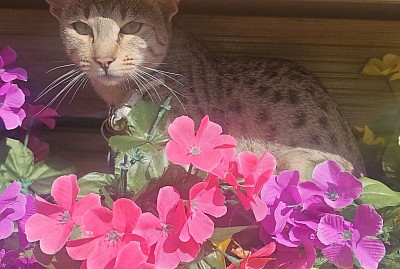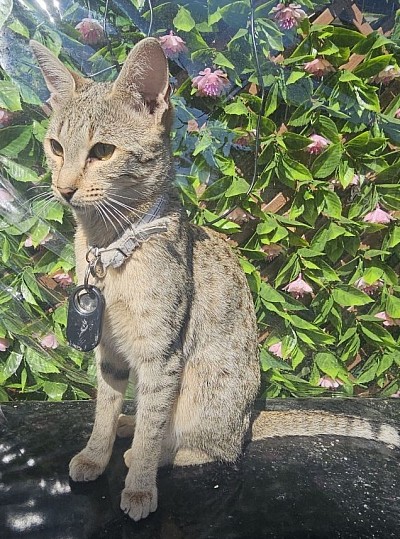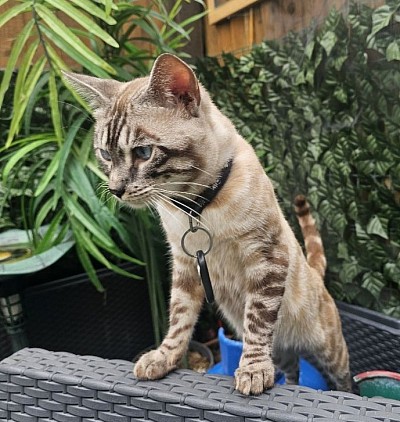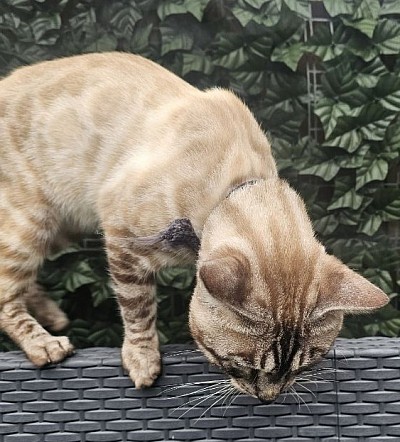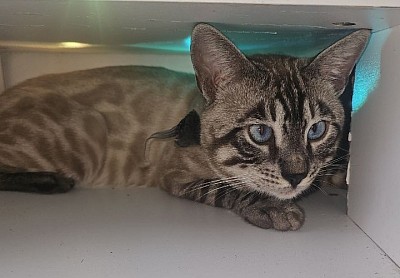Common Cat Myths
Common Cat Myths
Here are some of the most common cat myths, busted for you:
1. Cats have nine lives
Myth: Cats are thought to be super tough, almost like they can cheat death.
Fact: Cats are amazingly agile and have a neat righting reflex that helps them land on their feet, but just like any other living being, they only have one life. Their knack for surviving falls and tricky situations probably gave rise to this popular myth.
2. Black cats bring bad luck
Myth: In many Western cultures, black cats crossing your path are seen as a sign of bad luck.
Fact: This superstition goes way back to the Middle Ages when black cats were linked to witches and evil spirits. In truth, black cats are just like any other cats and can bring lots of joy and love. In fact, cultures like the Japanese and British actually see them as good luck symbols.
3. Cats are aloof and don’t like company
Myth: Cats are often seen as independent and distant, preferring to be alone.
Fact: Cats show affection differently from dogs, but they can form strong bonds with their humans and love interaction. They might head-butt, purr, or just hang out nearby to show they care. Some cats even get separation anxiety if left alone too long.
4. Cats always land on their feet
Myth: Cats have a magical ability to land safely on their paws after a fall.
Fact: Cats do have a built-in "righting reflex" that helps them twist mid-air to land on their feet, but it’s not foolproof. They can still get hurt or worse from falls, especially from high places. So, it’s important to keep windows and balconies secure to keep them safe.
5. Milk is good for cats
Myth: We often picture cats happily drinking milk, thinking it’s a healthy treat.
Fact: Most cats are actually lactose intolerant after they stop nursing, and drinking cow’s milk can cause tummy troubles like diarrhoea and cramps. Water and a balanced cat food diet are the best way to keep them hydrated and healthy.
6. Cats are nocturnal
Myth: Cats are believed to be most active at night, often disturbing their owners’ sleep.
Fact: Cats are actually crepuscular, meaning they’re most lively at dawn and dusk. This comes from their wild ancestors who hunted during these times to catch prey and avoid predators.
Knowing the truth behind these common cat myths helps us care better for our feline friends and appreciate just how special they really are. For the best advice on cat care, it’s always a good idea to chat with a vet or a trusted animal welfare group.
The Feline Enigma: A Comprehensive Multidisciplinary Analysis of Myth and Reality — Executive Summary
The Feline Enigma: A Multidisciplinary Analysis of Myth and Reality Executive Summary
This report provides a comprehensive, multidisciplinary analysis of the myths and superstitions surrounding cats. It deconstructs common feline folklore, tracing its historical and cultural origins while juxtaposing these beliefs with modern scientific understanding. The analysis reveals a profound duality in the human perception of cats: from ancient reverence as divine creatures to medieval demonization as agents of evil. The report demonstrates that many of the most enduring myths—such as the black cat's bad luck, the belief in nine lives, and the perception of feline aloofness—are less about the animals themselves and more about the evolution of human society, our fears, and our psychological tendencies to project meaning onto the natural world. Ultimately, it argues that these myths are a cultural mirror, reflecting our own changing values and anxieties across millennia.
The Timeless Fascination with the Feline Species
Introduction: The Enduring Allure of the Feline
The domestic cat (Felis catus) occupies a unique and paradoxical position in human history. For millennia, humanity has been captivated by the feline, a creature embodying both domestic companionship and wild independence. No other domesticated animal has been so consistently revered and reviled in equal measure, a duality that has birthed a vast tapestry of myths and superstitions. From the sacred deities of ancient Egypt to the witch's familiar of medieval Europe, the cat's image has been a fluid and often contradictory reflection of human culture. This report aims to move beyond a simple list of myths to provide a deeper, nuanced understanding of this relationship, synthesising historical, cultural, and scientific data to answer not just what the myths are, but why they have captivated and divided us for so long.
The Mythological and Historical Tapestry: The Sacred and the Sinister – A Compelling Historical Contrast
Part I: The Mythological and Historical Tapestry 1. The Sacred and the Sinister: A Historical Dichotomy
This section explores the dramatic shift in feline perception, from a sacred animal in antiquity to a demonised symbol in the Middle Ages. The cat's role in human society has been a pendulum, swinging between reverence and fear, driven by the rise and fall of different belief systems.
1.1. Divine Companions: Cats in Ancient Civilisations
For many ancient cultures, the cat was not merely a pet but a creature endowed with a powerful, often divine, essence. This reverence was rooted in the animal's natural attributes and its association with powerful deities. The most celebrated example is Ancient Egypt, where cats were held in the highest esteem. They were seen as sacred and associated with several key deities, serving as symbols of protection, fertility, and power.
Foremost among these was the goddess Bastet, who was initially depicted as a fierce lioness but later transformed into the image of a domestic cat. In her feline form, she was revered as a dutiful mother and a protector of the family, embodying grace and poise. Similarly, the goddess Sekhmet, the deity of war and destruction, was also depicted as a lioness, a testament to the respect ancient Egyptians held for the ferocity and strength of felines. The sun god Ra himself was represented by a cat in the Book of the Dead, where the cat is shown cutting through the snake deity Apopis, which highlights the cat's protective function against malevolent forces. This divine status was not merely symbolic; it had practical roots. Cats were essential for pest control, protecting valuable crops from rodents and, more critically, guarding homes and granaries against venomous snakes and scorpions. The profound reverence for these animals is evidenced by the practice of mummification for cats, who were sometimes buried with their owners, reflecting the hope that they would continue their companionship into the afterlife. The discovery of a tomb containing an estimated 80,000 mummified cats at Beni Hassan underscores the immense economic and spiritual importance they held in ancient Egyptian society.
In Norse mythology, cats occupied a different but equally significant position. They were inextricably linked to Freyja, the goddess of love, fertility, and luck, who rode in a chariot pulled by two large Norwegian Forest Cats. This association connected cats to themes of chance and destiny, and their unpredictable nature was seen as a reflection of life's own capriciousness. Cats were also featured in the epic myth of Thor's contest against the giant Utgarda-Loki. Thor was challenged to lift a seemingly innocuous giant grey cat, but could only manage to raise one paw before failing the feat. He was later told that the cat was in fact the Midgard serpent in disguise, demonstrating that felines in Norse lore were viewed as powerful, mystical creatures whose true nature was often concealed.
1.2. From Familiar to Fiend: The European Witchcraft Era
The positive perception of cats underwent a dramatic and brutal reversal in medieval Europe. As the early Christian church gained power, it sought to discredit pre-Christian pagan traditions, which often held a deep respect for the natural world. In this new religious and social climate, cats became symbols of darkness and the occult. The animal's independent nature and nocturnal habits were reinterpreted as sinister, leading to a widespread belief that they were in league with evil.
This demonisation was formalised on June 13, 1233, when Pope Gregory IX issued the papal bull "Vox in Rama". In a landmark decree, the document declared black cats to be an "incarnation of Satan". This was not a minor proclamation but a formal religious decree that marked the beginning of widespread, church-sanctioned hunts for heretics and witches. The church viewed witches as a direct competition for the "hearts and minds of the people". In a patriarchal society, the church feared both cats and the independent women accused of witchcraft, as both were seen as exhibiting a "healthy disrespect of authority" and a refusal to "fawn, like dogs, upon even the unworthy". The deep affection that some women had for their cats was seen as "diabolical," and the image of an "old lady with her cats became suspect". The belief that witches could transform into their cats or that cats were supernatural servants of witches ("familiars") became widespread, providing a convenient narrative to condemn both the woman and her animal.
This period is marked by a profound historical paradox. The persecution and widespread killing of cats, fueled by this superstition, led to a catastrophic imbalance in the ecosystem. With the natural predators of rodents decimated, the population of plague-carrying rats exploded. This inadvertently helped fuel the spread of the Bubonic Plague, the very disaster people blamed on the cats and their alleged evil connections. This tragic irony demonstrates how widespread, institutionally sanctioned folklore can have devastating and unforeseen real-world consequences.
The Scientific Reality: The Black Cat as a Symbol of Fortune or Destiny?
Part II: The Scientific Reality 2. The Black Cat: Omen of Fortune or Fate?
The most pervasive and enduring feline myth is the superstition surrounding black cats. The belief that a black cat brings bad luck is so deeply ingrained in Western culture that it has become a staple of Halloween imagery. However, this is not a universal truth. The significance of a black cat is entirely dependent on its cultural and historical context.
2.1. The Bad Luck Narrative: Origins and Evolution
The bad luck narrative has its roots in the medieval era and the institutional demonization of black cats by the Church. The belief that a black cat was an "incarnation of Satan" or a witch's familiar solidified its association with evil. The specific superstition of a black cat "crossing your path" developed from this core belief. It was thought that such a cat might be on a "mission from a witch" or could be the "devil in disguise," and therefore crossing its path was a foreboding omen of misfortune or harm. This fear was so deeply ingrained in European culture that it was carried across the Atlantic by Puritan colonists and continues to persist in modern Western societies.
2.2. The Good Luck Antagonist: Global Perspectives
The perception of black cats is not universally negative. In many cultures, they are seen as harbingers of good fortune and prosperity, a direct contradiction to the prevailing Western myth. In Scotland, a black cat arriving on one's doorstep is a sure sign of future prosperity for the household. The Japanese view black cats as omens of good luck and wealth, particularly for single women, with one legend suggesting that owning one can attract potential suitors. Even within Western cultures, maritime lore presents a counter-narrative, where sailors actively sought out black cats, believing they brought a safe voyage and good weather. Fishermen's wives would also keep them at home, hoping their influence would protect their husbands at sea.
The same animal, with the same physical characteristics, is perceived as a force for good or evil depending entirely on geographic location and cultural context. This demonstrates that superstitions are not based on objective reality but are socially constructed beliefs. The "bad luck" narrative is rooted in specific European historical events—the Inquisition and the witch trials—while the "good luck" narrative is tied to different cultural values, such as prosperity in Scotland or maritime safety. This shows that the meaning of a symbol is a product of its cultural environment, not an inherent quality.
The historical link between black cats and evil, solidified by powerful institutions like the Church, created a social bias that continues to influence perceptions today. This bias is evidenced by studies showing that black cats have lower adoption rates from shelters and are perceived as less friendly and more aggressive than other cats. Some research suggests this is due to the difficulty people have in interpreting the emotions of a black cat's face. This demonstrates a direct cause-and-effect relationship: historical superstition leads to modern-day bias and prejudice. It is a cycle where folklore, even when no longer consciously believed, continues to influence real-world outcomes and shapes the fate of these animals
Dispelling the Mystique: Scientific Insights Versus Superstitious Beliefs
3. Debunking the Uncanny: Science vs. Superstition
This section shifts from folklore to biology and psychology, using modern scientific data to provide an evidence-based explanation for the phenomena that inspired some of the most enduring myths.
3.1. The Nine Lives Myth: A Case Study in Feline Resilience
The myth that cats have nine lives is one of the most famous and widely accepted pieces of feline folklore, but its origins are multi-faceted and rooted in both historical anecdotes and the remarkable biological reality of the animal itself. The myth is often traced back to ancient Egypt, where the sun god Atum-Ra was said to take the form of a cat to visit the underworld and was associated with a pantheon of nine gods. Other cultural origins include an old English proverb stating that a cat has nine lives, "For three he plays, for three he strays and for the last three he stays". In Scottish mythology, a witch could transform into a cat nine times, with the ninth transformation trapping her in feline form.
The number nine itself has a long history of symbolic significance. It is considered an auspicious or magical number in many cultures, including Anglo-Saxon and Greek belief systems. Greek mythology, for instance, references the nine Muses, and the Chinese associate the number with strength and masculinity.
However, the enduring power of this myth lies in its connection to the observable, physical realities of feline biology. The myth is not simply a fantasy; it is a fantastical explanation for a biological fact. The primary scientific basis is the cat's innate ability to orient its body mid-air to land on its feet, a phenomenon known as the "righting reflex". This is a key example of a natural, physical ability being misinterpreted as supernatural. Cats have a flexible spine, powerful muscles, and a relatively large surface area to weight ratio that allows them to slow their descent and absorb impact, which contributes to their uncanny ability to survive significant falls with minimal injury. This combination of physical resilience and keen survival instincts creates a compelling feedback loop: the folklore is passed down, and human observation of a cat’s survival of a perilous situation reinforces the belief in multiple lives.
The number of lives attributed to cats varies by culture. In Spanish-speaking areas and Iran, cats are said to have seven lives, while in Turkey, they have six. This variation is significant because it demonstrates that while the core idea of feline resilience is a shared human observation, the specific numerical and symbolic details of the myth are subject to cultural transmission and local adaptation. This is evidence of a shared human experience filtered through different cultural lenses
Understanding Feline-Human Relationships: Insights into Cat Behaviour and Attachment
3.2. Beyond Aloofness: The Psychology of Feline-Human Bonds
One of the most persistent misconceptions about cats is that they are aloof, unfeeling, and fiercely independent, viewing humans merely as a source of food. This belief often leads people to prefer dogs, which are perceived as more demonstrative and affectionate. However, recent scientific studies in feline psychology have systematically challenged and debunked this myth.
Research has shown that cats form deep and secure attachments to their owners, a bond that is similar to that observed in dogs and human infants. A "Secure Base Test," used to evaluate the quality of attachment, revealed that a significant majority of both kittens (over 64%) and adult cats (almost 66%) displayed secure attachment to their owners. This means they feel comfortable exploring a new environment while their owner is present and show signs of distress when the owner leaves, but seek comfort and show reduced stress upon their return.
The myth of feline aloofness is a direct result of human failure to understand a species with a different social and evolutionary history. Cats are descended from solitary wildcats, unlike dogs, which evolved from pack animals. Their social cues and displays of affection are more subtle and nuanced than a dog’s. Humans have incorrectly labelled this subtlety as disinterest when, in reality, it is a different form of communication and a different expression of attachment. Cats have a unique way of communicating with humans through a combination of body language, scent markings, and vocalisations. For instance, meowing is a behaviour that cats have developed exclusively to communicate with people. Furthermore, cats respond positively to "slow blinking," a form of communication that fosters bonding and trust.
The perpetuation of the aloofness myth has tangible real-world consequences. It can devalue the cat-human bond and may lead to owners providing less mental and physical enrichment. This, in turn, can lead to behavioural issues such as separation anxiety, inappropriate urination, and aggression, creating a self-fulfilling prophecy where the animal's behaviour is a response to the owner's preconceived notions.
Scientific research has also shed light on other common misconceptions about felines:
Purring: While purring is a sign of contentment, it is also a self-soothing mechanism used when a cat is stressed, ill, or in pain.
Always Landing on Their Feet: As noted earlier, while a cat's righting reflex is real, it does not guarantee safety. Falls from high places can and do result in serious injuries.
Nocturnal: Cats are not nocturnal but crepuscular, meaning they are most active at dawn and dusk. This is a natural behaviour tied to their hunting instincts.
The Cat as a Reflection of Cultural Identity and Symbolism
Part III: The Cat as a Cultural Mirror
Beyond the realm of myth and biology, the cat has served as a powerful muse and a symbolic vehicle in human art, literature, and popular culture. Their mystique, independence, and grace have made them a versatile canvas for human ideas and a reflection of our changing artistic and societal values.
4. The Feline Muse: Portrayals in Art and Literature
Cats have been captivating artists for millennia, leaving their mark across various artistic periods. In ancient Egyptian art, cats were almost exclusively depicted as symbols of divinity and protection, a role reflected in sacred carvings and statues like the "Gayer-Anderson Cat". As the artistic world evolved, so did the portrayal of felines. In the Renaissance, Leonardo da Vinci's meticulous "Study of Cat Movements and Positions" showcased a shift from pure symbolism to a naturalistic appreciation for the cat's form and grace. Artists like Pierre-Auguste Renoir later captured cats in a more tender, domestic light, portraying them as affectionate companions in everyday scenes.
In literature, the cat serves as a potent and complex literary device, often symbolising independence, mystery, and the supernatural. Edgar Allan Poe's short story "The Black Cat" uses the feline as a menacing familiar, an inescapable reminder of a narrator's guilt and descent into madness, drawing directly from the old superstition that black cats are witches in disguise. In contrast, Lewis Carroll's enigmatic Cheshire Cat in Alice's Adventures in Wonderland embodies the whimsical and surreal, providing cryptic advice that challenges the protagonist's perception of reality. The literary cat also acts as a bridge between the human and a deeper, more mystical reality, as seen in Haruki Murakami's novels, where a character's ability to communicate with cats is key to the plot's magical realist elements.
5. From Screen to Symbol: The Cat in Popular Culture
The cat's journey into popular culture began in the early days of cinema, where it added whimsy and intrigue to silent films. As film evolved, so did the feline's role. Animated icons like the surrealist pioneer Felix the Cat and the heroic Puss in Boots cemented the cat's place as a memorable and charismatic character. In films like The Lion King, the cat's image was elevated to one of majesty and regal dignity, with characters like Simba serving as powerful symbols of strength and resilience.
Beyond straightforward portrayals, modern media continues to use the cat as a complex symbol. The character of Catwoman embodies the feline's allure, independence, and dualistic nature, blurring the lines between hero and villain and exploring themes of identity and agency. In a more realistic and grounded context, documentaries like Kedi, which follows strays in Istanbul, portray cats as symbols of resilience and community, highlighting a more compassionate and realistic view that counters the historical demonisation. These diverse portrayals in modern media demonstrate the enduring ability of the cat to serve as a muse for creatives, a symbol for complex human themes, and a living bridge between our domesticated lives and our wild past.
The Human Factor: Understanding the Endurance of Myths
Part IV: The Human Element: Why Myths Persist
Despite the wealth of scientific evidence debunking many feline myths, they continue to persist and influence human behavior. This final section synthesizes the report's findings, exploring the psychological and societal reasons why myths, despite being debunked, continue to hold sway.
6. The Cognitive and Societal Drivers of Superstition
6.1. The Psychology of Bias
The persistence of the black cat superstition is a powerful example of how historical folklore can create a lasting cognitive bias. Modern studies reveal that a significant number of people still hold a bias against black cats, which results in lower adoption rates and higher euthanasia rates in shelters. Research suggests that this bias is correlated with superstitious beliefs and that people often find it more difficult to read a black cat's facial expressions, which makes them seem less friendly or adoptable. This shows how a historical event—the papal decree and the subsequent witch hunts—has cast a long shadow over modern-day perceptions. The effect of the medieval decree is not gone; it has merely evolved into a subconscious bias, demonstrating how historical events can have tangible, long-term consequences that continue to shape the lives of these animals.
6.2. Mechanisms of Cultural Transmission
The perpetuation of folklore and traditions is a fundamental aspect of human culture. These beliefs are passed down through generations via mechanisms of "cultural transmission," which rely on imitation, communication, and storytelling. The longevity of cat myths suggests that they have served a function in human society, beyond mere entertainment. For instance, the fear-based myths may have served to reinforce social norms or provide a convenient scapegoat for societal problems, such as the plague. The "myth-as-adaptive-behavior" theory suggests that folklore, in its time, served an adaptive purpose. The story of the cat's link to evil, for example, served the Church's political agenda of suppressing paganism and controlling independent thought. The cat became a perfect vessel for these anxieties, with its unique blend of domesticated proximity and untamable wildness making it an ideal canvas for human projection.
Conclusion: The Intersection of Myth and Reality
The enduring myths about cats are not a failure of human intelligence but a testament to the powerful and complex relationship we have with these animals. The feline, with its blend of independence and affection, its remarkable agility, and its ancient association with both divinity and darkness, has provided humanity with a perfect canvas for its deepest fears and highest aspirations. As we move into an age of scientific understanding, the paradox remains: while we can explain the cat's purr and its righting reflex, its symbolic power continues to captivate. The myth of the cat, we find, is ultimately a rich and revealing story about us. The modern-day cat, rescued from the historical shadows of superstition, now stands as a beloved companion, a symbol of resilience, and a living bridge between our wild past and our domesticated present.
Mind-blowing facts about cats
You Probably Didn’t Know
Love picking up fun facts to wow your friends? You’re in the perfect spot! We’ve gathered some cool cat facts that every cat fan will enjoy.
1. When cats climb trees, they can’t come down headfirst because their claws all point the same way. So, they have to back down instead.
2. A group of cats is called a “clowder.”
3. According to a Hebrew legend, God created cats after Noah asked for help protecting the Ark’s food from rats. God made a lion sneeze, and out popped a pair of cats.
4. When your cat rubs its head on you, it’s not just being affectionate—they’re also marking you as part of their territory using scent glands on their face, tail base, and paws.
5. In the U.S., cats are actually more popular than dogs, with about 88 million pet cats compared to 75 million pet dogs.
6. Cats can’t taste sweetness. Scientists think this is because of a genetic mutation affecting their taste buds.
7. In Japan, it’s believed cats can turn into supernatural spirits after they die. This idea might come from Buddhism, which sees cats as temporary homes for powerful spirits.
8. Europe brought cats to the Americas in the 1750s to help control pests.
9. There are around 70 million feral cats in the U.S. alone, which shows why spaying and neutering pets is so important.
10. At the Dutch embassy in Moscow, two Siamese cats started meowing and scratching at the walls. Their owners found hidden microphones planted by Russian spies. The cats heard the bugs when they turned on, and instead of tipping off the spies, the owners pretended to talk about work delays, which actually sped things up.
11. When British antique dealer Ben Rea passed away in 1988, he left his $12.5 million fortune (about $26.7 million today) to his cat, Blackie. This made Blackie the richest cat ever, a record still held by Guinness World Records. The money was later shared among three cat charities that cared for Blackie until he died.
12. Some evidence shows domesticated cats have been around since about 3600 B.C.E., over 2,000 years before the Ancient Egyptians.
13. Cats meow only to communicate with humans.
14. Cats can recognise your voice, so if they seem to ignore you, that’s probably why.
15. When cats show the “Halloween Pose,” it’s a warning telling someone or something to back off.
16. The oldest cat video dates back to 1894 and is called “Boxing Cats.”
17. In ancient Egypt, when a family cat died, family members would shave off their eyebrows to show their mourning.
18. Cats and humans have very similar brain areas that control emotions.
19. Cats can move their ears independently and rotate them about 180 degrees.
20. While cats are often thought to have a lower social IQ than dogs, they can actually solve much more complex problems.
Feel free to share these fascinating facts with your friends!
Frequent Mistakes in Feline Care and Management
1. Making unexpected changes. Your cat likely regards your home and everyone within it as part of their territory. Just as you might be upset to find new furniture or a freshly painted bathroom upon returning home without notice, your cat is similarly unsettled by even minor changes. New furniture must be thoroughly investigated to ensure it poses no threat. New household members, whether human or animal, are met with suspicion until your cat is convinced they are not adversaries. Even alterations to your daily routine can distress many cats, who prefer predictability for a sense of security.
2. Smelling unpleasant. You may believe this sin does not apply to you, as you smell fine from a human perspective. However, cats possess a vastly different olfactory system. Scents that humans find pleasant can be repugnant to cats. For example, lemon-scented detergents and orange blossom shower gels, which humans associate with freshness, are offensive to feline noses, which are approximately fourteen times more sensitive than ours. The citrus aroma, enjoyable to humans, is akin to shoving a lemon slice up one’s nose from a cat’s point of view.
3. Being excessively loud. Cats are both predators and prey in the wild, making them naturally skittish and easily startled. Sudden loud noises—such as dropped objects, shouting, or barking dogs—can cause your cat to flee in terror. Their acute hearing, up to three times more sensitive than humans’, means that sounds like fireworks are nearly deafening.
4. Invading their territory. This sin is unlikely to be committed by humans but is significant among cats themselves. Cats are territorial and require a defined area they can defend. While some cats can share territory if resources are sufficient, unfamiliar cats are often viewed as invaders and driven away. Introducing new cats requires patience and gradual scent familiarisation.
5. Refusing to share food. Humans often enjoy diverse and flavorful meals, while cats typically consume dry kibble. Understandably, cats attempt to steal human food. In the wild, cats share prey with sick or nursing colony members, so withholding food is perceived as a grave offence.
6. Taking them to the veterinarian. Cats detest vet visits, which involve confinement, travel, and unfamiliar strangers administering injections or medications. Although necessary for their health, cats perceive these experiences as traumatic.
7. Dressing them in clothing. The deepest circle of feline hell is reserved for humans who dress cats in outfits, especially those covering the head, body, or paws. Cats rely heavily on their ears, whiskers, and paws for sensory input, and covering these areas causes distress. If dressing your cat is desired, collars and capes are less intrusive options.
Your bond with your cat may not be as strong as you believe. Cats perceive the world uniquely, and actions that seem harmless to you may be significant to them.
Mistake 1: Overindulging in treats. Cats often beg for treats, and it can be difficult to resist. However, frequent treats diminish their specialness and can reduce your cat’s affection. This phenomenon, known as the hedonic treadmill, means that constant rewards lose their impact, and your cat may feel slighted when treats are withheld.
Mistake 2: Scruffing your cat. The scruff is the loose skin at the back of a cat’s neck used by mothers to carry kittens. While kittens instinctively stiffen when scruffed, adult cats are too heavy for this and scruffing can cause pain or injury. Even scruffing on the ground causes mental distress and can damage your bond.
Mistake 3: Neglecting social interaction. Cats are independent but still require socialisation. Regularly leaving your cat alone for extended periods can lead to loneliness and distress.
Mistake 4: Overgrooming. Grooming needs vary by breed; long-haired cats require more frequent brushing. However, excessive grooming can overstimulate and stress your cat. Limit sessions to what your cat tolerates.
Mistake 5: Frequent rearrangement of the home. Cats are territorial and attached to their environment. Frequent or dramatic changes can cause anxiety and insecurity.
Mistake 6: Disturbing sleeping cats. Cats sleep up to 16 hours daily and value uninterrupted rest. Waking them abruptly can startle and distress them.
Mistake 7: Chasing your cat. Cats are prey animals and perceive being chased as a threat. Pursuing a fleeing cat damages trust.
Mistake 8: Denying hiding spaces. Cats need private spaces to retreat and relax. Lack of such spaces leads to stress and behavioural issues.
Mistake 9: Constantly pushing cats away. Repeatedly rejecting your cat’s attempts to interact can cause them to feel unwanted and reduce their social engagement.
Mistake 10: Ignoring body language. Understanding your cat’s ears, stance, and tail position is crucial. Relaxed ears and tail indicate contentment; flattened ears, wagging tail, and stiff posture signal discomfort.
Every cat owner must leave their cat alone occasionally. Despite cats’ independence, extended absences can cause problems. Here are eight common dangers cats face when left alone:
1. Boredom. Without stimulation, cats may engage in destructive behaviour. Provide toys and puzzle feeders to keep them occupied.
2. Breaking fragile items. Cats often knock objects off surfaces, risking injury from broken glass or ceramics. Secure breakables before leaving.
3. Insufficient water. Provide multiple water sources, especially for overnight absences, to prevent dehydration.
4. Lack of food. Prolonged fasting can cause hepatic lipidosis, a serious liver condition. Arrange for feeding if absent more than overnight.
5. Dangerous small objects. Items like hair ties and elastic bands can cause intestinal blockages if ingested. Keep these out of reach.
6. Extreme temperatures. Ensure your home remains within safe temperature ranges for your cat.
7. Hazardous play objects. Strings and cords can be dangerous if chewed. Hide electrical cords before leaving.
8. Trapping in enclosed spaces. Cats can become trapped in closets or cabinets. Secure or prop open doors to prevent this.
Eight critical mistakes define poor cat parenting:
1. Improper handling. Avoid scruffing adult cats; support their body properly.
2. Physical punishment. Never hit a cat; it damages trust and is ineffective.
3. Declawing. This painful and debilitating procedure is illegal in many countries and causes severe harm.
4. Pulling tails. The tail is connected to nerves controlling vital functions; pulling can cause incontinence.
5. Avoiding spaying/neutering. These procedures prevent unwanted behaviours and health issues; myths about their effects are unfounded.
6. Ignoring car safety. Cats may hide in car engine compartments during cold weather; always check before driving.
Common Errors in Cat Care Practices
Mistake 1
This represents one of the most critical errors a cat owner can make. Beneath the fender and above the tire of a vehicle lies a small gap, commonly referred to by mechanics as the "dead cat hole." This space often serves as a refuge for cats, particularly during the winter months when they seek warmth. When the vehicle is started and the wheels begin to turn, cats frequently cannot escape in time, resulting in fatal injuries. To prevent such tragedies, it is imperative to thoroughly inspect these areas on cold days to ensure the safety of your cats and your community.
Mistake 2
This pertains to feeding practices. Some cats behave like insatiable four-legged garbage disposals, persistently begging for more food and potentially consuming up to ten meals daily, including snacks and human food. While certain human foods are safe for cats in moderation—such as small portions of unseasoned egg, meat, or fish—some cats may also enjoy less common items like potatoes or carrots, which should be offered sparingly. However, several foods and ingredients are unequivocally harmful to cats, regardless of their insistence. Alliums, including garlic and onions, are toxic, as are citrus fruits and many herbs. Contrary to popular belief, cats are lactose intolerant; although milk is not fatal, it can cause digestive discomfort. Sugary and salty foods pose health risks since cats cannot properly metabolise them, and notably, cats cannot taste sugar, deriving no pleasure from it. Excessive consumption of fatty foods can lead to obesity, and attempts to correct this through dieting may result in a potentially fatal condition known as hepatic lipidosis (fatty liver disease). Additionally, while fish and chicken are appropriate for cats, their small bones can splinter easily and cause serious digestive complications.
Mistake 3
This concerns the use of collars for outdoor or indoor cats. Collars can be beneficial for identifying lost outdoor cats or enhancing the appearance of indoor cats. However, it is crucial to select the appropriate type of collar. Cats are natural climbers, adept at scaling trees, rooftops, cat trees, and furniture. The adage "a cat always lands on their feet" reflects their ability to twist midair and land safely. Nevertheless, if a cat’s collar becomes caught on an object during a fall, it can result in strangulation. To mitigate this risk, it is strongly recommended to use specially designed breakaway collars that release under pressure, sacrificing the collar to protect the cat’s well-being.
Is It Inhumane to Confine a Cat to a Single Room?
In most instances, it is inhumane to confine a cat permanently to a single room. Although cats often favor small, cozy spaces for resting, they are inherently curious and territorial animals that require ample space to explore, play, and climb to avoid boredom and stress.
Nonetheless, there are limited, temporary circumstances where restricting a cat to one room may be necessary and humane, including:
Introducing a new pet: To facilitate a smooth transition, a new cat or kitten may be confined to a single, fully equipped room for a period ranging from a few days to several weeks.
Post-surgical recovery: A veterinarian may advise confining a cat to a quiet room to restrict excessive movement during the healing process.
Medical observation: An ill cat may be isolated to monitor its condition, prevent disease transmission, or provide a tranquil environment for recovery.
Specific behavioral concerns: In rare cases, such as protecting a highly timid cat with social anxiety from a disruptive household, permanent confinement to a safe, enriching "sanctuary" room may be recommended by a veterinarian or feline behaviorist.
Why long-term confinement is detrimental
Prolonged confinement of a cat to a single room, particularly without adequate enrichment, can result in significant health and behavioral issues.
Behavioral problems: Cats experiencing boredom, stress, or anxiety may exhibit urine spraying, excessive grooming, destructive scratching, or aggression.
Physical health complications: Insufficient exercise can lead to obesity, while chronic stress may contribute to urinary tract disorders such as cystitis.
Psychological distress: Indicators of a stressed or unhappy cat include increased hiding, social withdrawal, loss of appetite, excessive vocalization, and alterations in normal sleeping and eating patterns.
Optimizing small spaces for cats
For those residing in small homes or studio apartments, it is feasible to provide a fulfilling environment for your cat by maximizing available space, thereby avoiding restrictive or inhumane confinement.
Maximize vertical space: Cats are natural climbers and enjoy elevated vantage points. Incorporate wall-mounted shelves, tall cat trees, and cat-friendly furniture to establish a three-dimensional territory.
Provide enrichment:
- Toys: Rotate toys regularly to maintain your cat’s interest. Interactive wand toys are particularly effective for physical exercise.
- Food puzzles: These stimulate your cat’s natural foraging instincts by requiring problem-solving to access treats or meals.
- Window access: A window perch allows your cat to observe birds and outdoor activity, offering valuable mental stimulation.
- Hiding spots: Provide secure retreats such as covered beds, cardboard boxes, or cozy hideaways to help your cat feel safe.
Ensure proper resource placement: Position food and water bowls separately from the litter box. For multi-cat households, supply additional litter boxes to minimize territorial conflicts.
Maintain active engagement: Dedicate daily one-on-one playtime and interaction to support your cat’s physical and emotional well-being.

